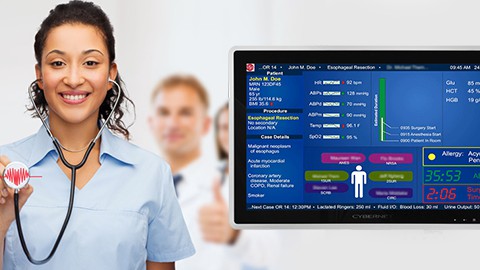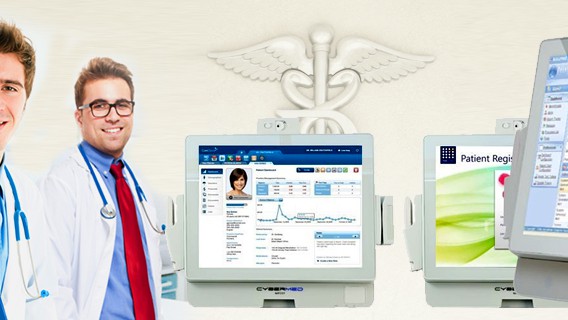Healthcare, despite its necessity and despite the love many practitioners have for the practice, is rife with its own issues and pain points. Across the board, several nurses, doctors, IT team members, and more all report issues of burnout and frustration, not with the nature of their work, but in many of the administrative and peripheral tasks that surround what they actually want to do: care for patients.
According to a 2019 physician burnout survey by Medical Economics, 54% of physicians who report burnout closely attribute it to either excessive reporting or issues with EHR software logins, both things that are closely tied to the hardware used to help physicians perform their jobs. As such, taking a look at the medical computer systems physicians use to navigate these burnout-causing tasks can help give us some insight into bypassing the common issues of healthcare staff.
So, without waiting for the healthcare sector or software developers to completely change, how can workstations simplify tasks such as reporting, transportation, documentation, and all of the other non-care related tasks that burnout staff?
While there are several answers and methods, hot swap battery computers are one that remain incredibly effective across several use cases and across several wings of the care facility.
What is a Hot Swappable Battery?
Article Guide
The term “hot swappable” doesn’t only apply to batteries. The phrase is used to designate any component or peripheral that can be removed from a computer (and theoretically swapped out) without causing damage or affecting performance. A hot swappable battery then, is one that can be changed and replaced without powering down the machine drawing energy from that battery. Commonly, this is possible because the device is actually being powered by multiple batteries. When one is removed to be charged or replaced, the second or third battery sill inside the device can keep it powered on, allowing for continuous operation.
Hot Swappable Battery Use Cases
While the idea of theoretically limitless up-time for a medical workstation is promising in and of itself, when you take a look at how hot swappable batteries enhance workflow and patient outcomes across specific departments, that’s when the true value of the innovative tech becomes much more apparent.
Below are only a few of the ways these batteries address common burnout causes and optimize care across several care professions.
Nursing
While nurses often have a choice in whether they work 3, 4, or 5 days a week, their typical work days last 8 hours a day on the lower end and 12 hours on the more average range of the spectrum. A traditional workstation on wheels setup might give you 6 hours of uptime before the cart battery needs to be plugged in to recharge. That can take another 4-6 hours. Meaning these WoWs are essentially dead weight for nearly half of a typical shift. Either that, or clinicians are forced to change their workflow and do their charting in the hallways instead of in real time at the patient bedside.
Not only that, but those heavy carts often times lead to injury. A recently updated study from the National Center for Biotechnology Information explains are all too common in the nursing profession. According to their included surveys, at least 50% of nurses comment that they have at least at one point in time experienced debilitating back pain as a result of their job with the two most common causes being the lifting of heavy patients and the transportation of heavy medical equipment. Even more unfortunate, 10-20% of these nurses also reported that these bouts of occupational-related low back pain resulted in their seeking a change in employment altogether.
Nursing requires a mobile workstation in order to provide the highest quality of care – at the bedside. The mobility afforded by hot swap battery medical cart computers is changing the game in this regard. By having the computer itself provide its own power through internal batteries, nursing staff can opt to use computer carts that aren’t loaded down with incredibly heavy power sources. Doing so can save nurses from experiencing common injuries such as back pain, muscle strain, and torn ligaments – all health issues
And a hot-swap computer can offer close to triple the battery life, or even 24/7 operation if the hot swap technology is utilized.
Operating Rooms
According to a survey by BMC Anesthesiology, hardware issues remain one of the top 5 common pain points of anesthesiologists in the operating room. Furthermore, when participants were asked what aspects of their hardware impacted them negatively the most, 25% reported the existence of cluttered cables while another 20% commented that the weight of their monitoring devices and their lack of maneuverability were the most impactful.
Hot swappable batteries address both of these concerns. Firstly, they lighten the weight of COWs by cutting the need for heavy battery-powered carts. Secondly, they eliminate the need for power cables connecting to an outlet. Furthermore, battery powered medical computers can also power externals and peripherals that are connected to them. This eliminates even more cord clutter and even opens the door to barcode scanning applications that allow surgeons to scan surgical tools for quick confirmations on whether or not they have been properly sanitized.
Telehealth
Telehealth applications have boomed in the year 2020 as several appointments and care practices have transitioned to being conducted over video calls. And while this has surely enhanced the availability of care, attention still needs to be placed on the privacy of these conversations that take place over phone calls. Whether it be tele-triaging, general remote check ins, or contact tracing interviews, these conversations are filled with personal details and patient-doctor-confidentiality needs to be maintained.
It’s here where we see the mobility afforded by hot swappable batteries come into play again. Nurses, clinicians, doctors, and surgeons can all easily wheel lightweight COW stations into secluded rooms or telehealth appointment offices in order to have these private conversations with their patients. Furthermore, when it comes to creating a proper remote patient monitoring program, there are several peripheral devices that often require their own power sources. A hot swap battery enabled computer can have all of these peripherals plugged into and powered by the computer itself, allowing for providers to continue providing remote care both privately, and effectively, and all while eliminating clutter.
The Financial Benefit of a Hot Swap Battery Solution
Battery-powered carts are more than bulky, they’re costly as well. A recent study on COW station implementation by the US National Library of Medicine National Institutes of Health highlighted that most battery powered, mobile workstations cost on average over $3,000 for a single unit. And these prices don’t even include the computer or peripherals that would need to be loaded onto the cart. Couple that with the fact that this money spent would still require care providers to keep their carts plugged into an outlet for several hours to recharge the cart battery AND the fact that the cart would be much heavier and harder to maneuver (a pain point emphasized and lamented in both the nursing and surgical fields) and it becomes hard to make a case for battery powered carts.
A hot swappable battery-powered computer, on the other hand, eliminates the need for the powered cart altogether, allowing facilities to opt instead for much cheaper non-powered carts. In many cases, a facility can purchase a hot swap battery powered computer for cheaper than a battery powered cart and commercial computer and use the savings to buy extra batteries and battery charging stations. The NCBI study even confirms this by reading the invoices of a facility that decided to switch from traditional battery-powered cart stations to leaner, hot-swap enabled devices – explaining that the former costed nearly 80% more per workstation.
Hot Swappable Battery Computers Open the Door to Many Other Innovations
Hot swappable battery computers aren’t a specific tech innovation with a specific use case. Rather, they’re optimized workstations for healthcare providers that open the door for several other innovative programs. Whether it be EHR note-taking practices that were all the rage in the past, telehealth applications that are booming today, or the next future innovation to rock healthcare, hot swap workstations make their adoption all the easier by streamlining the basest parts of every provider’s work day. For more information on battery-powered medical computers and tablets and how they can advance your particular practice, contact an expert from Cybernet today.
Why Fanless Medical Computers are a Must for the Medical Profession
July 9, 2015
The enterprise industries and the healthcare profession have been greatly affected by the increasing use of all-in-one computers and similar devices. The healthcare profession has grown to rely more and more on medical…
0 Comments5 Minutes
How Medical Grade Computers Improve the Standard of Care in the Medical Profession
August 3, 2015
The face of the healthcare industry has changed drastically in the past decade. Now, the use of devices like medical grade computers in patient rooms, emergency rooms, and operating rooms have allowed healthcare service…
0 Comments6 Minutes
How Medical Grade Computers Are Benefitting Chiropractic Clinics
November 13, 2015
Man and machine are made to complement each other, especially when it comes to medicine. They go hand by hand, which is why professionals work with high-end equipment to produce fast, accurate data. This, in return,…
0 Comments4 Minutes
You Can't
Learn from a Pop-up
But we can deliver knowledge to your inbox!
We dive deep in the industry looking for new trends, technology, news, and updates. We're happy to share them with you.
Knowledge, News, and Industry Updates Right in Your Inbox





